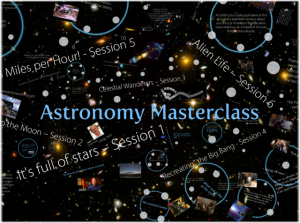It's full of stars: Difference between revisions
No edit summary |
No edit summary |
||
| (3 intermediate revisions by the same user not shown) | |||
| Line 2: | Line 2: | ||
{{Rinfo | {{Rinfo | ||
|type= Lesson idea | |type= Lesson idea | ||
|final=yes | |||
|attribution={{Andrew Jackson}} | |attribution={{Andrew Jackson}} | ||
|title=It's full of stars | |title=It's full of stars | ||
| Line 19: | Line 19: | ||
|useful information= | |useful information= | ||
|related resources= | |related resources= | ||
* [[88 Miles per hour]] | |||
* [[Astronomy Master Class]] | * [[Astronomy Master Class]] | ||
* [[Celestial Wanderers]] | |||
* [[From Earth to Moon]] | * [[From Earth to Moon]] | ||
* [[Recreating the Big Bang]] | * [[Recreating the Big Bang]] | ||
|other= | |other= | ||
|format=An 18 minute narrated screen cast which is part of the full, six hour 'Astronomy Master Class'. Also supplied as a Prezi and an Acrobat file should you wish to do the presentation yourself. The [[Astronomy Master Class]] overview explains how the resource was used. | |format=An 18 minute narrated screen cast which is part of the full, six hour 'Astronomy Master Class'. Also supplied as a Prezi and an Acrobat file should you wish to do the presentation yourself. The [[Astronomy Master Class]] overview explains how the resource was used. | ||
|resources=[[It's full of stars/Teacher Notes|Teacher Notes]] | |resources= | ||
* [[It's full of stars/Teacher Notes|Teacher's Notes]]<br /> | |||
* Narrated video - 18 mins http://www.youtube.com/watch?v=JZSMRCjTUBE <br /> | * Narrated video - 18 mins http://www.youtube.com/watch?v=JZSMRCjTUBE <br /> | ||
* Astronomy Master Class - Prezi Slide presentation - http://prezi.com/2hk390sfkqjh/the-astronomy-masterclass/ <br /> | * Astronomy Master Class - Prezi Slide presentation - http://prezi.com/2hk390sfkqjh/the-astronomy-masterclass/ <br /> | ||
Latest revision as of 11:21, 4 October 2012
Lesson idea. This session involves practical astronomy. It describes what you can expect to see through a telescope and outlines how a telescope works. This is session 1 of a series of 6 entitled Astronomy Master Class
Teaching approach. Astronomy(topic) has been practiced for centuries and doesn't require expensive equipment! This first session aims to train the whole class(ta) to use a telescope and, hopefully, to provide an opportunity to engage in some active learning(ta). The lesson includes some naked-eye observations and describes how modern technology helps scientists know where to look. You can explore the scientific method(ta) and language(ta) at this point, using targeted questioning(ta)/differentiation(ta). Students may be able to engage in an inquiry(ta)-based project around this work, perhaps for homework(ta). (edit)
| Resource details | |
| Title | It's full of stars |
| Topic | [[Topics/Astronomy|Astronomy]] |
| Teaching approach | [[Teaching Approaches/Differentiation|Differentiation]], [[Teaching Approaches/Homework|Homework]], [[Teaching Approaches/Questioning|Questioning]], [[Teaching Approaches/Whole class|Whole class]], [[Teaching Approaches/Language|Language]], [[Teaching Approaches/Active learning|Active learning]], [[Teaching Approaches/Inquiry|Inquiry]], [[Teaching Approaches/Scientific method|Scientific method]] |
| Learning Objectives |
|
| Format / structure | An 18 minute narrated screen cast which is part of the full, six hour 'Astronomy Master Class'. Also supplied as a Prezi and an Acrobat file should you wish to do the presentation yourself. The Astronomy Master Class overview explains how the resource was used. |
| Subject | [[Resources/Science|Science]] |
| Age of students / grade | [[Resources/Secondary|Secondary]], [[Resources/Year 10|Year 10]]
|
| Related ORBIT Wiki Resources | |
| Files and resources to view and download |
|

